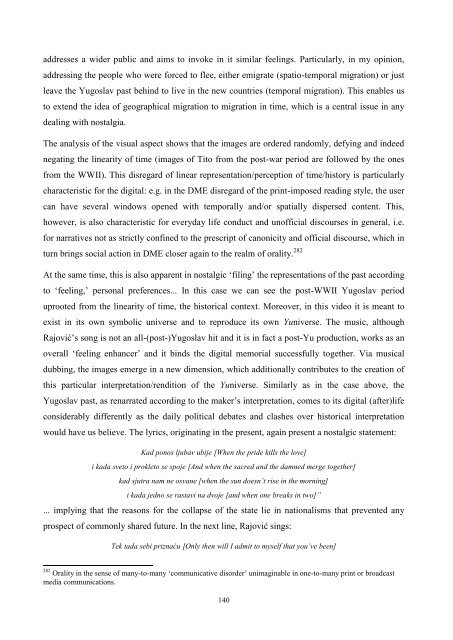UNIVERSITY OF NOVA GORICA GRADUATE SCHOOL ...
UNIVERSITY OF NOVA GORICA GRADUATE SCHOOL ...
UNIVERSITY OF NOVA GORICA GRADUATE SCHOOL ...
Create successful ePaper yourself
Turn your PDF publications into a flip-book with our unique Google optimized e-Paper software.
addresses a wider public and aims to invoke in it similar feelings. Particularly, in my opinion,<br />
addressing the people who were forced to flee, either emigrate (spatio-temporal migration) or just<br />
leave the Yugoslav past behind to live in the new countries (temporal migration). This enables us<br />
to extend the idea of geographical migration to migration in time, which is a central issue in any<br />
dealing with nostalgia.<br />
The analysis of the visual aspect shows that the images are ordered randomly, defying and indeed<br />
negating the linearity of time (images of Tito from the post-war period are followed by the ones<br />
from the WWII). This disregard of linear representation/perception of time/history is particularly<br />
characteristic for the digital: e.g. in the DME disregard of the print-imposed reading style, the user<br />
can have several windows opened with temporally and/or spatially dispersed content. This,<br />
however, is also characteristic for everyday life conduct and unofficial discourses in general, i.e.<br />
for narratives not as strictly confined to the prescript of canonicity and official discourse, which in<br />
turn brings social action in DME closer again to the realm of orality. 282<br />
At the same time, this is also apparent in nostalgic ‗filing‘ the representations of the past according<br />
to ‗feeling,‘ personal preferences... In this case we can see the post-WWII Yugoslav period<br />
uprooted from the linearity of time, the historical context. Moreover, in this video it is meant to<br />
exist in its own symbolic universe and to reproduce its own Yuniverse. The music, although<br />
Rajović‘s song is not an all-(post-)Yugoslav hit and it is in fact a post-Yu production, works as an<br />
overall ‗feeling enhancer‘ and it binds the digital memorial successfully together. Via musical<br />
dubbing, the images emerge in a new dimension, which additionally contributes to the creation of<br />
this particular interpretation/rendition of the Yuniverse. Similarly as in the case above, the<br />
Yugoslav past, as renarrated according to the maker‘s interpretation, comes to its digital (after)life<br />
considerably differently as the daily political debates and clashes over historical interpretation<br />
would have us believe. The lyrics, originating in the present, again present a nostalgic statement:<br />
Kad ponos ljubav ubije [When the pride kills the love]<br />
i kada sveto i prokleto se spoje [And when the sacred and the damned merge together]<br />
kad sjutra nam ne osvane [when the sun doesn‘t rise in the morning]<br />
i kada jedno se rastavi na dvoje [and when one breaks in two]‖<br />
... implying that the reasons for the collapse of the state lie in nationalisms that prevented any<br />
prospect of commonly shared future. In the next line, Rajović sings:<br />
Tek tada sebi priznaću [Only then will I admit to myself that you‘ve been]<br />
282 Orality in the sense of many-to-many ‗communicative disorder‘ unimaginable in one-to-many print or broadcast<br />
media communications.<br />
140

















